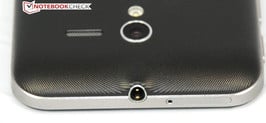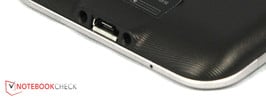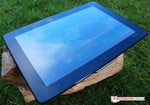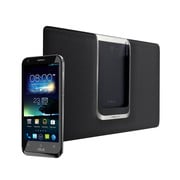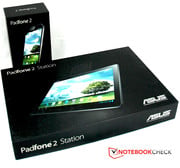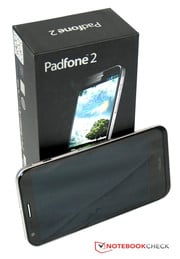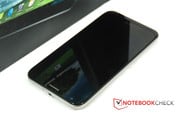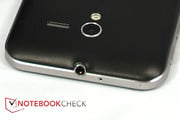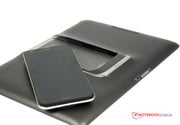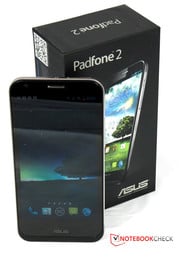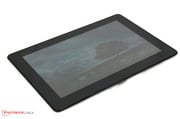华硕PadFone 2 智能手机测评

Editor's Note (December 21, 2012): The following review has not yet been edited for grammatical errors. A final draft of the review will be released soon.
For the original German review, see here.
No, we have no ethical concern about how low-necked the Asus PadFone 2 is. The station of the PadFone 2 looks impressive nonetheless: a sleek, premium looking 137.9x68.9x9 mm large smartphone, which docks at the back of the 263x180.8x10.4 mm large station without a cover. Our review will reveal whether this new freedom is as practical as it is chic. The Asus PadFone 2 has changed not only on the outside, but also on the inside: the powerful Quad Core 1.5 GHz Qualcomm Snapdragon S4 Pro processor ensures that the PadFone 2 has not only the looks, but also the brains. While the predecessor had only 1 GB of RAM, the new model goes further with a total of 2 GB RAM. As for the display: the first generation had a 4.3-inch Super AMOLED display with crisp colors and good contrast. The PadFone 2 relies on a 4.7-inch Super IPS panel with a resolution of 1280x720 pixels. The IPS panel of the tablet has the handy size of 10.1 inches and a resolution of 1280x800 pixels. In the following review we will look into how the display and overall concept of the PadFone 2 fares to the PadFone 1.
编者按(2012年12月21日):下面的审查尚未被编辑语法错误。最后草案的审查将很快被释放。
对于的德国原装审查,在这里看到。
不,我们没有道德的关注低领华硕的PadFone2。该站的PadFone2的外观令人印象深刻的仍然没有盖的一个圆滑的,优质寻找137.9x68.9x9毫米大的智能手机,在后面的263x180.8x10.4 mm大站码头。我们的审查,就会发现这种新的自由是否是不切实际的,因为它是别致。华硕的PadFone2的已不仅改变了在外面,但在里面:强大的四核1.5 GHz的高通Snapdragon S4 Pro处理器,确保PadFone2,不仅外观精美,而且还绞尽脑汁。虽然只有1 GB的RAM的前身,新的模式更进了一步,总的2 GB RAM。至于显示:第一代有一块4.3英寸的Super AMOLED显示屏,明快的色彩和良好的对比度。 PadFone依赖于一个4.7英寸的Super IPS面板,分辨率为1280x720像素。 IPS面板的平板电脑拥有方便的尺寸为10.1英寸,分辨率为1280x800像素。在下面的检讨中,我们将研究如何显示和整体概念的PadFone2票价的PadFone1。
Case
Sleek, chic, light. This is the first impression that the PadFone 2 leaves us with. Taking the smartphone in hand we notice the low weight of 135 grams, the sleek design, and appealing material of the back. Just like the predecessor it is made of plastic, with fine grooves forming concentric circles. But it is no longer in the grey-brown tone, instead comes in classy, matte black. The rough surface offers good grip and is safe from unattractive fingerprints. Visually appealing is also the surrounding frame made of matte brushed aluminum. The embedded volume rocker and power button are also made of the same metal material and add to the overall quality impression. The edges are pleasantly rounded, burr-free, and do not scratch the ear while talking on the phone. Everything is good, both in terms looks and feel. Asus has opted for a 4.7-inch (previously 4.3) display. Thus the „waist“ of the smartphone is only 9 mm, right on the „thin" line: a clear step away from bulgy pockets.
Black makes you slim. In the case of the PadFone 2 station, this is less due to the color choice – the tablet has been slimmed considerably: measuring 263x180.8x10.4 mm it is a good 3 mm thinner than the 13.55 mm "thick" predecessor. This is mainly due to the lack of an opening panel. A cover has been completely omitted. Another difference: the smartphone is no longer inserted sideways, but vertically into the bay at the back of the station. The new docking method cannot change the fact that the use of the tablet on a desk is a wobbly experience. The back of the PadFone 2 station is just as uneven as that of its predecessor.
The station has also undergone a facelift in terms of the material and color used. The plastic back of the station is black as well, but unlike the smartphone, it does not have the fine grooves - instead it is lightly rubberized. This ensures a secure handling and good grip. The matte black back still attracts fingerprints. Overall the case leaves a high-quality impression, is stiff, and can barely be twisted.
时尚,别致,重量轻。这是PadFone 2,给我们留下的第一印象。以智能手机在手,我们发现低克重135克,采用流线型设计,和有吸引力的材料的背面。一样的前身,它是由塑料制成的,用细槽,形成同心圆。但它不再是在灰棕色色调,而不是优雅,磨砂的黑色。粗糙的表面提供良好的抓地力和没有吸引力的指纹是安全的。视觉上的吸引力是磨砂拉丝铝周围的框架。嵌入的音量键和电源按钮也由相同的金属材料,并加至的整体质量的印象。愉快圆润的边缘,无毛刺,并在电话交谈时,不要划伤耳朵。什么都好,无论是在外观和感觉。华硕选择了一个4.7英寸(4.3以前)显示。因此,“腰”的智能手机是仅9毫米,就在“薄”行:一个明确的一步之遥,从凸出的口袋。
黑色让你苗条。在的PadFone 2站,这是由于颜色的选择 - 平板电脑已大大瘦身:测量263x180.8x10.4毫米它是一个很好的3毫米厚度比13.55毫米“厚”的前身。这主要是由于缺乏的开口面板。一个盖已被完全忽略。另一个不同之处:智能手机不再插入横盘整理,但在后面的站到海湾垂直。新的对接方法不能改变的事实,使用的平板电脑放在桌子上是一个摇摇晃晃的经验。其前身是不均匀的的PadFone 2站的背面。
该站使用的材料和颜色也发生了改款。车站的塑料背面是黑色为好,但与智能手机,它并没有细槽 - 而是轻轻橡胶的。这确保了安全处理和良好的抓地力。磨砂黑背仍然吸引了指纹。总体来说,留下高品质的印象,是僵硬的,可以勉强被扭曲。
Connectivity
Since the tablet itself is nothing more than a touch screen with a battery, we take a closer look at the features of the clever duet partner - the PadFone 2.
The PadFone 2 boasts the brand new 1.5 GHz Qualcomm Snapdragon S4 Pro APQ8064A Quad Core processor and 2 GB RAM, powerful equipment, which ensure good performance in tablet mode as well. The Adreno 320 graphics chip provides a high image quality - according to the manufacturer it can unleash its full potential with the installed Super IPS panel.
The interfaces can be listed quickly: the PadFone 2 features a microSIM card slot and a 13-pin dock connector (it supports micro USB 2.0 and Mobile High Definition Link for HDMI). The Padfone 2's charging port is at the bottom. The predecessor had this port on the side of the unit, which made talking while charging the phone somewhat awkward. The audio jack is located in the middle of the upper edge. Asus has omitted the expandable memory this time - the PadFone 2 is available with 32 GB or 64 GB memory.
The station itself has, in addition to the essential smartphone connector, a 13-pin port (Micro USB 2.0 Host) for charging.
由于平板电脑本身是没有什么比触摸屏的电池,我们来仔细看看聪明的对唱合作伙伴的特点 - PadFone2。
的PadFone2拥有全新的1.5 GHz的高通Snapdragon S4 Pro的APQ8064A四核处理器和2 GB RAM,强大的设备,确保良好的性能,以及在平板模式下。了Adreno320图形处理芯片,提供了高图像质量 - 根据制造商,它可以充分发挥其潜在与已安装的超级IPS面板。
接口可以迅速:PadFone的microSIM卡插槽和一个13针的基座接口(支持micro USB 2.0和HDMI移动高清链接)。 Padfone2的充电端口是在底部。的前身端口上侧的单位,说手机充电时有点尴尬。音频插孔位于在中间的上边缘。华硕省去了扩展内存的时间 - PadFone2是32 GB或64 GB内存。
该站本身,除了必要的智能手机连接器,13针微型USB 2.0主机端口()进行充电。
Software
The PadFone uses Android 4 Ice Cream Sandwich. An upgrade to Android 4.1 has been promised by the manufacturer. Noteworthy feature of the PadFone 2 is the "intuitive" handling. When changing from the smartphone to the tablet, the displayed content will be automatically transferred to the tablet's screen and adapted to the new format. Active applications recognize the moment of change and continue seamlessly. The predecessor sometimes needed a reconnection to the station, in order to resume the running applications. We'll see later on if this problem is present in the PadFone 2. Another innovation: the PadFone 2 offers a new version of the app SuperNote, which transforms handwriting into typed text. In addition, the Instant Translation application translates texts in e-mails and websites, thus making third-party translation tools obsolete according to the manufacturer.
PadFone采用了Android冰淇淋三明治。制造商已经承诺升级到Android4.1。值得一提的功能的PadFone2的“直觉”的处理。从智能手机到平板电脑时,显示的内容将自动转移到平板电脑的屏幕上,并适应新的格式。活动应用程序的变化和认识的那一刻,继续无缝地。其前身有时需要重新连接到了车站,以恢复运行的应用程序。我们将在后面看到,如果这个问题出现在PadFone2。另一项创新:PadFone2 SuperNote的应用程序,这将手写内容转换成键入的文本提供了一个新的版本。此外,即时翻译应用程序将文本电子邮件和网站,从而使第三方翻译工具已经过时按照制造商。
CommuniCation & GPS
Bluetooth 4.0 allows wireless data transmission to other Bluetooth-enabled devices – only over short distances of course. On the road, the PadFone 2 can connect to the Internet via the high speed HSPA+ or LTE standards, the next stage of UMTS. The supported frequency bands are: 900 and 2100 MHz for 3G and 800, 1800 and 2600 MHz in 4G networks. The initial satellite lock with the integrated GPS module takes a couple of minutes. Reception remains stable only near the window.
Cameras & Multimedia
At the back of the PadFone we find a 13-megapixel camera. Therefore, at least on paper, the PadFone 2 is superior to most cell phone cameras. But this high theoretical quality is brought "down to earth" by a somewhat small sensor. Asus has made a good choice with the aperture of f2.4. The manufacturer has upgraded the new model heavily in comparison to the PadFone 1, which only had an 8-megapixel camera. New is the Burst Mode, which can take up to 100 photos at six shots per second.
The camera is really good for a cell phone: the colors are great and we cannot fault the sharpness either. With 13 megapixels, the PadFone 2 is definitely among the better equipped smartphones.
Both the phone and the station feature a front-facing camera, which is located above the display and has a resolution of 1.2 megapixel in the smartphone and one megapixel in the tablet. As it is expected, the quality is not amazing, but suffices for video chats, for example over Skype.
Accessories
In addition to the AC adapter, in the box we find a charging cable for the Padfone 2 and the station. This is a positive upgrade - the previous model had two different charging cables, but only one AC adapter. The annoying unplugging is over, since the 13-pin connector fits on both devices. In the package there are also instructions and warranty information, as well as in-ear headphones, including earbud replacements.
Asus has omitted the PadFone Stylus, which was supplied with the first generation and served as an input device and headset in one. The Station Dock, the optional keyboard for the first PadFone, will not be available for the current model. Instead, Asus offers the user a 50 GB online storage, free for a period of two years.
Warranty
Asus delivers the PadFone 2 and the station with a two-year warranty, including Pick-Up&Return Service. The warranty applies to Germany and Austria.
Games
Modern games such as Need for Speed: Hot Pursuit and Raging Thunder 2 run smoothly with the integrated Adreno 320 graphics chip. There are small stutters here and there, but they are almost not worth mentioning. The responsive gyroscope does the rest. Nothing stands in the way of enjoying the occasional game.
Input Devices & Controls
Prompt and reliable – this is how the capacitive touch screen of the Android 4.0 Ice Cream Sandwich based PadFone 2 reacts. While the first generation's display did not always "react" instantly, the one on the Padfone 2 scores points with its responsiveness and precision. The 10.1-inch tablet display does not – at least subjectively – fall behind the smaller device. Both the station and smartphone fared equally well in rotating display content 180 degrees.
Overall the mobile duet makes a good impression in terms of handling and control. This has been improved: the first PadFone model wobbled a bit when inserted in the station. A reliable and instantaneous transfer of the image to the tablet was not always the case and the user was greeted with a black screen now and then. The PadFone 2 manages the connection and the screen content adjustment significantly better.
On the other, the 13-pin connector is not so succesful. It is really small and very fragile, making it somewhat clumsy to use. The 5 mm connector can be easily damaged by plugging it in at the wrong angle or even upside down. Cautious use is advised. The same is true for the station connector. Because there is no cover any more, the smartphone docking connector is out in the open and is not protected from dirt or physical damage. Therefore, the tablet should be protected accordingly, especially when travelling.
Display
Just like the first generation, the tablet has a 10.1-inch IPS panel covered with a scratch resistant Corning Glass and a resolution of 1280x800 pixels. Let's take a look at the illumination: the maximum brightness at the nine measurement points is between 267 and 316 cd/m2 and is thus slightly higher than the predecessor. As before, it lacks a bit of luminance for an enjoyable outdoor use. Although the values have been improved, subjectively not much has changed: the brightness remains less than ideal and the reflective surface is not helping either.
However, Asus has changed a lot on the smartphone's display. First of all, it is now 4.7 inches, larger than the 4.3-inch predecessor. The manufacturer has also changed the Super AMOLED panel for an IPS one. The IPS panel has a resolution of 1280x720 pixels and is significantly better than the display of the predecessor. Crystal clear images and a very good black level follow as a result. The maximum brightness at the nine measurement points was between 495 and 558 cd/m2.
| |||||||||||||||||||||||||
Brightness Distribution: 89 %
Center on Battery: 542 cd/m²
Contrast: 2168:1 (Black: 0.25 cd/m²)
In terms of measured values, the smaller duet partner is significantly ahead and leaves the tablet display out in the cold. The PadFone 2 is also subjectively better. This is so because of the higher brightness and great contrast ratio, which in turn is due to the good black level. This is especially noticeable when displaying darker images.
Performance
The Asus PadFone 2 is equipped with a Qualcomm Snapdragon S4 Pro APQ8064A Quad Core processor running at 1.5 GHz. The device features 2 GB of system memory and an Adreno 320 graphics chip. The 32 or 64 GB flash memory of the Padfone 2 provide a comfortable amount of storage space. Android 4.0 Ice Cream Sandwich runs smoothly. An upgrade to Android 4.1 Jelly Bean should be available shortly.
Performance comparison with other devices is not easy since the PadFone 1 and 2 are unique smartphone-tablet hybrids. Therefore we have chosen both tablets and smartphones for the comparison of benchmark results.
The PadFone 2 has been dealt very good cards and can even take on full-fledged tablets. In the performance benchmark Androbench 3 the Padfone 2 surpasses the Samsung Galaxy Note 10.1 with a sequential read rate of 43.45 MB/s. The Samsung Galaxy Note 10.1 only manages 31.85 MB/s. Androbench 3 shows that the main strength of the Padfone 2's installed memory is its speed. In Random Mode, the Padfone 2 again makes devices such as the Fujitsu Stylistic M532, the Samsung Galaxy Note 10.1, as well as its own „big brother“, the original PadFone, look "old". However, the write rate is only average. In Sequential and Random Mode both the old and new PadFone models are at the very back of the list.
The upper-class smartphone HTC One S also joins the battle. The HTC smartphone stands no chance against the PadFone 2 in the Antutu Benchmark V2 and its RAM test. Here the Padfone 2 delivers the top score of 3544 points and leaves behind even the Samsung Galaxy Note 10.1. In the Database I/O test by Antutu Benchmark the HTC One S with 480 is a bit ahead of the PadFone 2's 465 points.
Our PadFone 2 stubbornly refused to run the performance test GLBenchmark and responded with several system crashes. Therefore, results are unavailable.
In the graphics benchmark NenaMark 2 the PadFone, PadFone 2, and the HTC One S are on par with about 60 fps.
| AnTuTu v2 | |
| SD Card Read (sort by value) | |
| Asus Padfone 2 | |
| Asus Padfone | |
| Samsung Galaxy Note 10.1 | |
| HTC One S | |
| Fujitsu Stylistic M532 | |
| SD Card Write (sort by value) | |
| Asus Padfone 2 | |
| Asus Padfone | |
| Samsung Galaxy Note 10.1 | |
| HTC One S | |
| Fujitsu Stylistic M532 | |
| Database IO (sort by value) | |
| Asus Padfone 2 | |
| Asus Padfone | |
| Samsung Galaxy Note 10.1 | |
| HTC One S | |
| Fujitsu Stylistic M532 | |
| RAM (sort by value) | |
| Asus Padfone 2 | |
| Asus Padfone | |
| Samsung Galaxy Note 10.1 | |
| HTC One S | |
| Fujitsu Stylistic M532 | |
| Total Score (sort by value) | |
| Asus Padfone 2 | |
| Asus Padfone | |
| Samsung Galaxy Note 10.1 | |
| HTC One S | |
| Fujitsu Stylistic M532 | |
| Geekbench 2 - 32 Bit - Total Score (sort by value) | |
| Asus Padfone 2 | |
| Asus Padfone | |
| Samsung Galaxy Note 10.1 | |
| HTC One S | |
| Fujitsu Stylistic M532 | |
| AndroBench 3-5 | |
| Random Write 4KB (sort by value) | |
| Asus Padfone 2 | |
| Asus Padfone | |
| Samsung Galaxy Note 10.1 | |
| Fujitsu Stylistic M532 | |
| Random Read 4KB (sort by value) | |
| Asus Padfone 2 | |
| Asus Padfone | |
| Samsung Galaxy Note 10.1 | |
| Fujitsu Stylistic M532 | |
| Sequential Write 256KB (sort by value) | |
| Asus Padfone 2 | |
| Asus Padfone | |
| Samsung Galaxy Note 10.1 | |
| Fujitsu Stylistic M532 | |
| Sequential Read 256KB (sort by value) | |
| Asus Padfone 2 | |
| Asus Padfone | |
| Samsung Galaxy Note 10.1 | |
| Fujitsu Stylistic M532 | |
| NenaMark2 - --- (sort by value) | |
| Asus Padfone 2 | |
| Asus Padfone | |
| Asus Padfone | |
| Samsung Galaxy Note 10.1 | |
| HTC One S | |
| Fujitsu Stylistic M532 | |
In the browser based benchmark Google V8 the Padfone 2 shows a solid, although not outstanding result. Here, it is on par with the HTC One S. Genuine tablets such as the Samsung Galaxy 10.1 Note are the reigning champions here.
Sometimes less is more: in the Javascript benchmark Sunspider the Padfone 2 is slightly better than the predecessor. Here, it manages 1385.5 ms, while its brother reached 1625.3 ms.
| Google V8 Ver. 7 - Google V8 Ver. 7 Score (sort by value) | |
| Asus Padfone 2 | |
| Asus Padfone | |
| Samsung Galaxy Note 10.1 | |
| HTC One S | |
| Fujitsu Stylistic M532 | |
| Sunspider - 0.9.1 Total Score (sort by value) | |
| Asus Padfone 2 | |
| Asus Padfone | |
| Samsung Galaxy Note 10.1 | |
| HTC One S | |
| Fujitsu Stylistic M532 | |
* ... smaller is better
Emissions
Temperature
The temperatures of the Asus PadFone 2 can be described as extremely discreet: even under full load for several hours, at no point was the casing hotter than 37.7 degrees C; under normal usage it reached a maximum of 33.3 degrees C. The station of the Padfone 2 also remains cool under full load and reached a maximum of 39.4 degrees C. At 43 degrees C, the AC adapter is a bit on the hot side; under normal usage it reaches 27.2 degrees C, which is still far from the critical level.
(+) The maximum temperature on the upper side is 35.8 °C / 96 F, compared to the average of 35.1 °C / 95 F, ranging from 21.9 to 63.7 °C for the class Smartphone.
(+) The bottom heats up to a maximum of 37.7 °C / 100 F, compared to the average of 33.9 °C / 93 F
(+) In idle usage, the average temperature for the upper side is 30 °C / 86 F, compared to the device average of 32.8 °C / 91 F.
Speakers
The SonicMaster stereo speakers are located at the right side of the station's back. Although they are visually unspectacular, the sound that comes from the "couple of tiny holes" on the back is not too bad. The bass could be a bit louder, but overall the sound quality is quite good for a tablet.
Power Consumption
In idle state the Padfone 2 consumes 1.2 W at minimum brightness. At maximum brightness and WLAN switched on the device draws 1.9 W. Under full processor load this value is 3.9 W, while during the stability test with both CPU and GPU under load it consumes 6.1 W. By the way: in the new version of the PadFone, the smartphone is still charged by the station's battery, while used in tablet mode.
| Off / Standby | |
| Idle | |
| Load |
|
Key:
min: | |
Battery Life
With a maximum run time of 18 hours and 13 minutes in the Reader's test with minimum brightness, the Padfone 2 shows a lot of stamina. Equipped with a 2140 mAh Lithium-Polymer battery, the smartphone promises to be an enduring mobile companion. The first PadFone ran out of steam after 10 hours in the Reader's test. In the more realistic WLAN browsing test with brightness set at 150 cd/m2, the battery was empty after 9 hours. Under full load, the battery lasted 3 hours and 9 minutes. If the smartphone is connected to the tablet, the WLAN browsing time increases to 16.5 hours, because it benefits from the 5000 mAh battery of the station.
Verdict
At first glance, the PadFone 2 looks chic and well made. The new "freedom" at the back suits the mobile duet well. The unsheltered insertion of the PadFone into the tablet not only looks good, but also has its advantages: the opening and closing of the cover are gone, the switch from phone to tablet is quick and possible with one hand. Disadvantages of the new coverless design: the sensitive pin connectors, which lock the smartphone in place, are now unprotected. We advise caution, because the pins can be damaged easily and dirt can accumulate in the socket. The same is true for the charging port and the connector of the cable. The connection port is very fragile. Plugging it at the wrong angle can lead to permanent damage. This makes it somewhat cumbersome to use.
On the other hand, the hardware equipment is a success. The brand new Quad Core 1.5 GHz Qualcomm Snapdragon S4 Pro processor provide lots of power under the hood. Fast browsing and smooth come as a result. The IPS panel of the PadFone 2 is also convincing: bright colors, sharp image, and high contrast make the display a joy to look at, especially on the smartphone. Can the smartphone-station combo replace a "true" tablet - the question remains open in the case of the PadFone 2 as well. There's also the steep price of 800 Euros (~$1062) for the 32GB model. For 64 GB the customer will have to pay about 900 Euros (~$1195). Those who enjoy powerful „gadgets“, can do without the option to expand the memory, and would not mind the wobbly typing experience, due to the non-flat back of the station, might find the hybrid solution to be an interesting alternative to a standard tablet.





